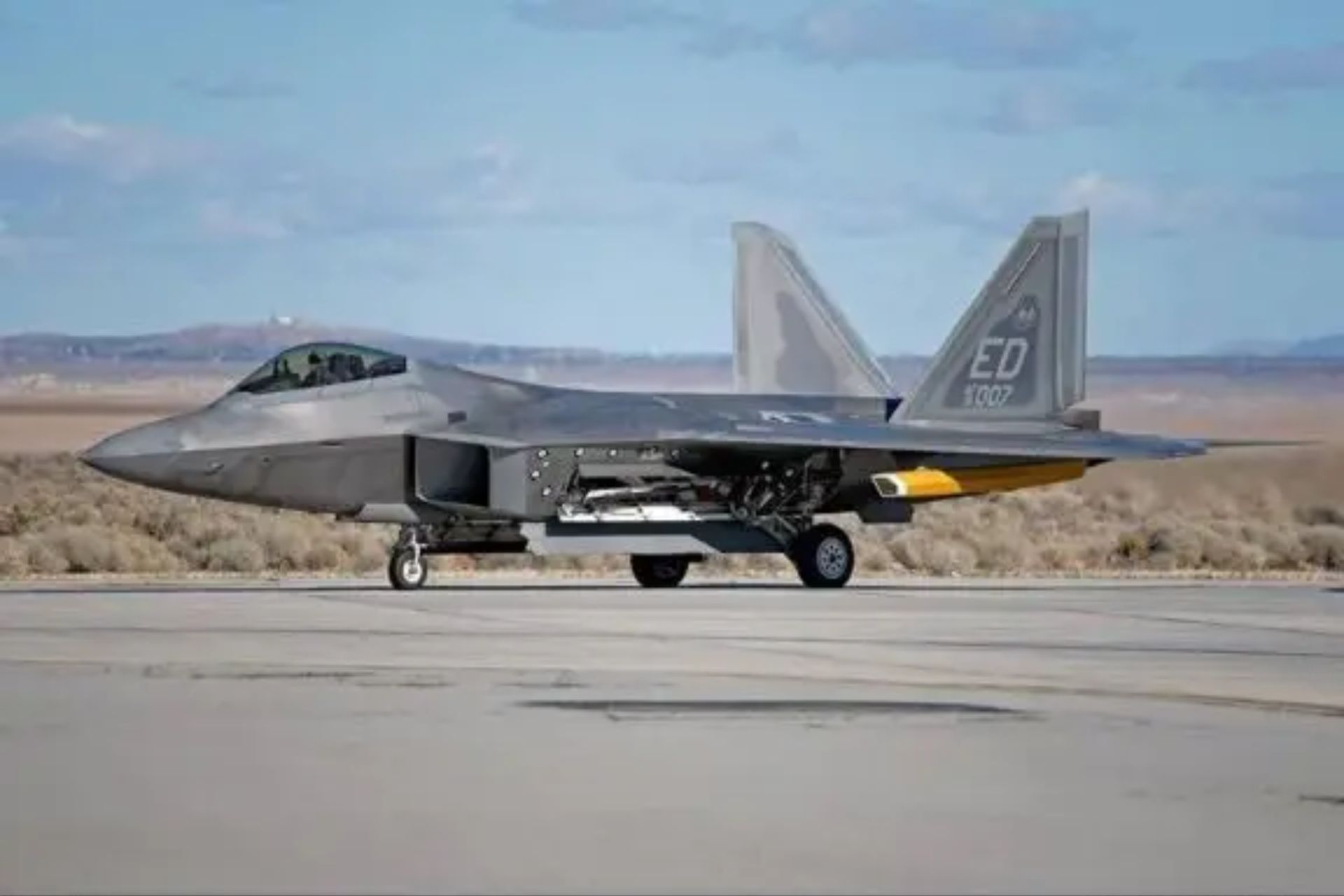Future Optical Equipment dedicated to NGAD Spotted on an F-22

{loadposition bannertop}
{loadposition sidebarpub}
It is well known that the famous American Raptor serves as a test platform for technologies that could later be incorporated into the innovative Next Generation Air Dominance (NGAD) program, which aims to develop a promising sixth-generation fighter jet. This may explain why an unknown electro-optical pod was spotted on the F-22 Raptor by OSINT sources.Follow Army Recognition on Google News at this link
F-22 Raptor spotted on US Air base with in tests optical pod (Picture source: OSINT)
Photos of the aircraft with what appears to be a test pod, based on its color and position, were found online, although their exact capture date remains uncertain. The bright yellow color of this device makes it stand out against the otherwise subdued color scheme of the jet.
Although the NGAD program is not limited to the creation of a sixth-generation fighter jet, it is its primary component. It is expected that this fighter will partially replace the fifth-generation F-22 Raptor currently in service with the U.S. military. At Edwards Air Force Base in California, there is a special facility responsible for conducting flight tests of a promising new fighter. Additionally, new technologies are being developed there for potential future integration into the F-22.
At the same time, the reverse process is also underway: testing Raptor technologies and devices that are planned to be incorporated later into the NGAD program. Previously, three different types of experimental coatings were applied to the F-22’s body for testing purposes. Additionally, various pods with different functions have been installed under the wings of the fighter.
Since March 2024, different photos of F-22s equipped with yellow devices in various locations have been observed. These show F-22s with different auxiliary fuel tanks, slightly different coatings—such as highly reflective ones or radar-absorbing ones—and so on.
We also know that IRST technology (Infrared Search and Track) is making a strong comeback within the U.S. Air Force, which could explain this pod. The IRST system is used primarily in military and defense sectors for detecting and tracking targets based on their thermal (infrared) signatures, without emitting active signals like radar does.
Additionally, military doctrine dictates that air missions typically involve two aircraft. When it comes to ground bombardment, high-precision bombs are guided by laser, so this new pod could fit within this developmental logic.
Another hypothesis for this pod, motivated by the optical device visible at its front, suggests that it could be an optical reconnaissance pod. Such pods can equip aircraft for missions that may not be feasible for observation satellites or drones. For example, a stealth aircraft could safely conduct reconnaissance in an airspace secured against aerial threats, whereas an observation drone might not. The war in Ukraine and the downing of a U.S. MQ-9 drone over the Black Sea highlighted the vulnerability of drones to aerial threats. While awaiting the development of the loyal wingman, which combines stealth with flight capabilities similar to manned aircraft, the use of reconnaissance pods remains relevant. This hypothesis seems likely, given that an aircraft can program multiple passes over a target in a long-term operation, something satellites—restricted by their orbital path—cannot do.

{loadposition bannertop}
{loadposition sidebarpub}
It is well known that the famous American Raptor serves as a test platform for technologies that could later be incorporated into the innovative Next Generation Air Dominance (NGAD) program, which aims to develop a promising sixth-generation fighter jet. This may explain why an unknown electro-optical pod was spotted on the F-22 Raptor by OSINT sources.
Follow Army Recognition on Google News at this link
F-22 Raptor spotted on US Air base with in tests optical pod (Picture source: OSINT)
Photos of the aircraft with what appears to be a test pod, based on its color and position, were found online, although their exact capture date remains uncertain. The bright yellow color of this device makes it stand out against the otherwise subdued color scheme of the jet.
Although the NGAD program is not limited to the creation of a sixth-generation fighter jet, it is its primary component. It is expected that this fighter will partially replace the fifth-generation F-22 Raptor currently in service with the U.S. military. At Edwards Air Force Base in California, there is a special facility responsible for conducting flight tests of a promising new fighter. Additionally, new technologies are being developed there for potential future integration into the F-22.
At the same time, the reverse process is also underway: testing Raptor technologies and devices that are planned to be incorporated later into the NGAD program. Previously, three different types of experimental coatings were applied to the F-22’s body for testing purposes. Additionally, various pods with different functions have been installed under the wings of the fighter.
Since March 2024, different photos of F-22s equipped with yellow devices in various locations have been observed. These show F-22s with different auxiliary fuel tanks, slightly different coatings—such as highly reflective ones or radar-absorbing ones—and so on.
We also know that IRST technology (Infrared Search and Track) is making a strong comeback within the U.S. Air Force, which could explain this pod. The IRST system is used primarily in military and defense sectors for detecting and tracking targets based on their thermal (infrared) signatures, without emitting active signals like radar does.
Additionally, military doctrine dictates that air missions typically involve two aircraft. When it comes to ground bombardment, high-precision bombs are guided by laser, so this new pod could fit within this developmental logic.
Another hypothesis for this pod, motivated by the optical device visible at its front, suggests that it could be an optical reconnaissance pod. Such pods can equip aircraft for missions that may not be feasible for observation satellites or drones. For example, a stealth aircraft could safely conduct reconnaissance in an airspace secured against aerial threats, whereas an observation drone might not. The war in Ukraine and the downing of a U.S. MQ-9 drone over the Black Sea highlighted the vulnerability of drones to aerial threats. While awaiting the development of the loyal wingman, which combines stealth with flight capabilities similar to manned aircraft, the use of reconnaissance pods remains relevant. This hypothesis seems likely, given that an aircraft can program multiple passes over a target in a long-term operation, something satellites—restricted by their orbital path—cannot do.





